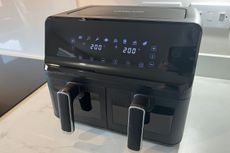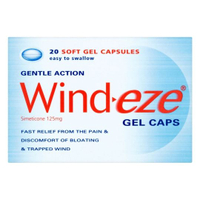How to get rid of trapped wind: What causes it and how can you prevent it happening?
Bloated? Get rid of trapped wind with our health editor’s fast tips


Need to beat the bloat? Learning how to get rid of trapped wind is one of the best ways to combat common digestive issues.
If you've been wondering why is my stomach bloated, trapped wind is caused by a whole host of factors, from minor diet changes to conditions like IBS and lactose intolerance. And when it comes to how to improve gut health, and beat trapped wind, many people look to ease their discomfort with natural remedies for bloating, sometimes you need something to act a little faster. From fast, effective relief to breads that won't make you bloat, this is how to ease trapped wind quickly.
It's important to note that flatulence, passing wind, farting - whatever you want to call it - is totally normal. "A certain amount is a sign of a healthy gut," says Dr Megan Rossi (AKA The Gut Health Doctor). "10-20 times a day is considered 'normal' and indicates your inner community of microbes are well-fed and happy, busy fermenting the leftovers as part of good digestion." So what's not normal? Here's how to get rid of trapped wind safely and easily.
How to get rid of trapped wind
1. Take a Wind-eze
Wind-eze relieves stomach pain and bloating caused by trapped wind. Simeticone is the active ingredient in these small, soft gel capsules that works as an anti-flatulence medication. They gently disperse the trapped wind in your system by pushing out bubbles of air without any chance of embarrassment.
Both the tablets and gel caps are available to buy from the pharmacy and are suitable for adults and children over 12 years old, and can be taken three or four times a day, when needed to relieve symptoms - such as after a meal or before going to bed.
<a href="https://www.awin1.com/awclick.php?awinmid=2041&awinaffid=103504&clickref=hawk-custom-tracking&p=https%3A%2F%2Fwww.boots.com%2Fwind-eze-20-gel-caps-10007151" data-link-merchant="boots.com"" target="_blank" rel="nofollow">Wind-eze 20 Gel-Caps - £4.45 | Boots
20 easy to swallow capsules to relieve abdominal pain, flatulence, bloating, wind or other symptoms caused by a build up of trapped gas in the stomach or intestines.
2. Drink a peppermint tea
A study conducted at Tufts University in Boston, USA, found that peppermint relaxes the gut and relieves intestinal spasms. This in turn helps to combat unpleasant symptoms of bloating and pain, like trapped wind. Similar research from 2018 shows that peppermint can alleviate abdominal pain, bloating and other digestive issues.
But be sure to drink your peppermint, instead of taking peppermint leaf tablets or similar. The potency of the leaf is significantly higher in tea than oral capsules.
GoodtoKnow Newsletter
Parenting advice, hot topics, best buys and family finance tips delivered straight to your inbox.
3. Do some star jumps
While a HIIT workout may not be on the cards for when you're struggling with trapped wind, a couple of gentle star jumps could certainly help things along. In fact, any action where there's a real up and downwards motion can have a positive effect. For instance, touching your toes will also help.
Moving your whole body around causes the intestines to move about too, meaning that the bubbles of gas lodged by digestion are released.
4. Go for a brisk walk
Similarly, more prolonged and gentle exercise will help to ease trapped wind. A study by University Hospital Vall d'Hebron in Spain proves that a long walk, a brisk run or even a stint on the cross-trainer helps to prevent bloating and ease any stomach issues. Physical movement of any kind really does work wonders in pushing out gas from your body that causes discomfort and pain.

Whatever you choose to do, to feel the full effect you should make sure it's for at least 30 minutes.
5. Avoid foods that bloat while your stomach recovers
After you've done activities to ward off the bloat, stick to foods that won't reverse the cure.
Cabbage, cauliflower and beans are some of the worst culprits for causing trapped wind, according to one 2012 study, so be sure opt for different veggies with your dinner. All the different bean varieties are also worth staying away from as these contain raffinose. As a type of carbohydrate that the body struggles to digest, bacteria in the large intestine has to gear up to break it down, resulting in gas and uncomfortable bloating.
6. Yoga
- The supine twist: Lie back on the floor, legs outstretched. Turn your neck to look over your right shoulder, whilst bending your right leg and bringing it over your left. Hold this for a while. Then swap sides.
- Halasana: This one does require a certain level of flex but if you can nail this pose and hold it for a few seconds, you might find yourself relieved fairly quickly of air.
- Child's Pose: On all fours, push your bum back to touch down on your heels. Then drop your chest and forehead to the floor, extending arms out in front of you. For added pressure, rock back and forth.
Yoga can help with so many ailments and there are some yoga moves that ease period pain, but these particular poses can put pressure on internal organs, helping to release that unwanted air.
7. Drink water
Keeping hydrated is one of the best things you can do to ease trapped wind - although with a bloated stomach, it's normally the last thing you'll want to do.
Drinking water helps ease trapped wind in two different ways. Firstly, it keeps waste moving through the digestive tract in the body. With waste ready to be removed, bowel movements become more regular which helps with constipation, one of the main causes of trapped wind.
Secondly, water reverses the impact of high sodium foods on the body. Foods with a high salt content push excess sodium into the body which in turn causes bloating, according to Harvard studies on the condition, because sodium causes the body to retain water. Drinking water helps the body to get rid of this excess sodium through waste products such as urine. This is another reason why alternative diets, such as the low salt diet, are also popular.
Similarly, water can help fibre to dissolve better in the body which can help to ease trapped wind and bloating issues.
8. Lie on your front and apply pressure to your abdominal muscles
While not a scientifically proven method, it's one that reportedly works for many people.
"A best friend of mine many years ago recommended this and it stuck in my head ever since. When my tummy is sore and bloated, in a bid to relieve it, I often lie on my bed, legs hanging off the edge. I use my hands to press down quite hard on my lower abdominals. In time, I start to feel things moving," explains Lucy Gornall, health and fitness writer at Goodto.com and bloating sufferer.
Similarly, you can try easing trapped wind by massaging your stomach area from the top. Start just below the rib cage, Lucy suggests, and move down to your lower abdominals. "It's almost as though you're following the pocket of gas all the ways through the intestines," she says.

How to prevent trapped wind
1. Avoid foods that cause trapped wind
- Raw cabbage
- Cauliflower
- Broccoli
- Brussels sprouts
- Dried fruit
- All varieties of beans, whether baked or raw
Our expert says it's also a good idea to limit your protein intake as a high protein diet can cause digestive issues.
"Try limiting protein to 1kg per kilogram of your bodyweight daily for 2 weeks. Then if you want to increase, try balancing higher protein with fibre (e.g. wholegrains or vege) at each meal," Dr Megan Rossi says.
2. Avoid drinking alcohol
If you're trying to avoid having to get rid of trapped wind in the future, stay away from alcohol. While it might sound like a big step if you enjoy a glass of wine in the evening, a lot of alcoholic drinks contain sulfur - particularly wine. When sulfur doesn't properly absorb into your small intestine, it leads to flatulence issues.
The health benefits of not drinking alcohol are well-documented for a number of reasons. But you don't necessarily have to ditch the booze permanently to ease stomach problems. Instead of wine, opt for something lighter on the stomach - like a gin and tonic.
3. Stay away from sweeteners
Sweeteners like xylitol and sorbitol have been known to cause digestive issues, Dr Rossi says. This is because "they're hard for your small intestine to absorb and can lead to a bacteria feast, producing excess gas."
Similarly, stay away from fructose if you're looking for how to get rid of trapped wind. This is a fruit sugar in table sugar, syrups and sweeteners, dried fruit, juices from concentrate and other processed foods. Our bodies find it difficult to digest too much of this sugar at one time and it can build up in the large intestine where it ferments and gives off gas.

4. Try the FODMAP diet
For a short time, this could certainly work.
The low fodmap diet is a scientifically researched plan, created by nutritionists Peter Gibson and Susan Shepherd at Melbourne University in Australia, to help those suffering with Irritable Bowel Syndrome (IBS). It's now the main way health experts handle the condition in Australia and many people around the world have taken up the plan to ease their uncomfortable IBS symptoms.
Foods to avoid include dairy products, particularly chocolate, cream-based foods, soft cheeses and milk. While the go-to foods and FODMAP recipes to opt for on the diet include loads of vegetables, fruit, meat and fish, oats and brown rice.
Dr Rossi says a maximum of four to six weeks on the diet should help ease trapped wind, bloating and other stomach-related issues.
Luckily once you know how to get rid of trapped wind, it's relatively easy to do it quickly an easily.
Related features:
- The best time to eat breakfast, lunch and dinner
- How to lose weight in your face
- How to get rid of a double chin
- How to get rid of cellulite
- Best exercises for bingo wings
Video of the Week

Dr Rossi qualified as a dietitian with a first class honours in Dietetics from the University of Queensland, before embarking on a PhD in gut health. In 2015 she joined King’s College London, where she continues to work as a Research Fellow leading research to investigate nutrition-based therapies in gut health, and received the Dean’s Award top 5% for Outstanding Research Higher Degree, recognising her contribution to science. In 2017, she founded The Gut Health Doctor, which helps people enjoy good gut health with books, clinics, gut-loving food products, easy-to-digest advice and diverse recipes. Dr Rossi's first book, Eat Yourself Healthy, was published in 2019 and became an Amazon and The Sunday Times bestseller.

Freelance writer Lucy Gornall is the former health and fitness editor for various women’s magazines including Woman&Home Feel Good You. She has previously written for titles including Now, Look and Cosmopolitan, Woman, Woman's Own, Woman's Weekly and Chat. She lives and breathes all things fitness.
-
 I tested the Lakeland Dual Basket air fryer and it made midweek family cooking a breeze
I tested the Lakeland Dual Basket air fryer and it made midweek family cooking a breezeYou can’t go wrong with the dual basket air fryer by Lakeland complete with easy-view windows to ensure burnt food is a thing of the past…
By Jessica Dady Published
-
 Reframing one simple habit could get your sex life back on track after having a baby, new research shows
Reframing one simple habit could get your sex life back on track after having a baby, new research showsMany parents struggle to get their sex life back on track after having a baby, but new research has shown how one simple habit could make all the difference.
By Ellie Hutchings Published
